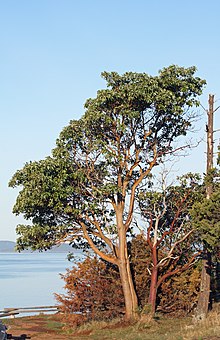Pacific Madrone
| Pacific madrona | |
|---|---|
 |
|
| Scientific classification | |
| Kingdom: | Plantae |
| (unranked): | Angiosperms |
| (unranked): | Eudicots |
| (unranked): | Asterids |
| Order: | Ericales |
| Family: | Ericaceae |
| Genus: | Arbutus |
| Species: | A. menziesii |
| Binomial name | |
|
Arbutus menziesii Pursh |
|
 |
|
| Natural range of Arbutus menziesii | |
| Synonyms | |
|
|
Arbutus menziesii (Pacific madrona, madrone or arbutus) is a species of tree in the family Ericaceae, native to the western coastal areas of North America, from British Columbia to California.
It is also known as the madroño, madroña, or bearberry. The name "strawberry tree" (A. unedo) may also be found in relation to A. menziesii (though it has no relation to the strawberry fruit). In the United States, the name "madrone" is used south of the Siskiyou Mountains of southern Oregon and Northern California and the name "madrona" is used north of the Siskiyou Mountains, according to the "Sunset Western Garden Book". The Concow tribe calls the tree dis-tā’-tsi (Konkow language) or kou-wät′-chu. In British Columbia it is simply referred to as arbutus. Its species name was given it in honour of the Scottish naturalist Archibald Menzies, who noted it during George Vancouver's voyage of exploration.
Arbutus menziesii is an evergreen tree with rich orange-red bark that when mature naturally peels away in thin sheets, leaving a greenish, silvery appearance that has a satin sheen and smoothness. The exposed wood sometimes feels cool to the touch. In spring, it bears sprays of small bell-like flowers, and in autumn, red berries. The berries dry up and have hooked barbs that latch onto larger animals for migration. It is common to see madronas of about 10 to 25 metres (33 to 82 ft) in height, but with the right conditions trees may reach up to 30 metres (98 ft). In ideal conditions madronas can also reach a thickness of 5 to 8 feet (1.5 to 2.4 m) at the trunk, much like an oak tree. Leaves are thick with a waxy texture, oval, 7 to 15 centimetres (2.8 to 5.9 in) long and 4 to 8 centimetres (1.6 to 3.1 in) broad, arranged spirally; they are glossy dark green above and a lighter, more grayish green beneath, with an entire margin. The leaves are evergreen, lasting a few years before detaching, but in the north of its range, wet winters often promote a brown to black leaf discoloration due to fungal infections. The stain lasts until the leaves naturally detach at the end of their lifespan.
...
Wikipedia
